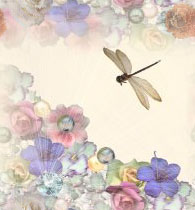Lore of the Fae….a Workshop
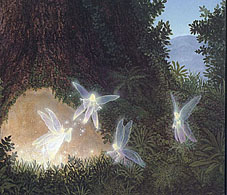
History of Faeries
"Faerie" is the generic term for all creatures, mistakenly called 'supernatural', who are neither in God's nor the devil's service. Faries inhabit most countries of the world, but each nation has its particular cultural group. Irish Leprechauns, Scottish Brownies and German Kobolds are all faeries, all independent of religion and quite natural in movement, taste and manners.
In Ireland two distinct faerie types exist - the trooping faeries and the solitary faeries. The trooping faeries are to be found in merry bands about the hawthorn tree or at feasts in gilded faerie places. They delight in company, while the solitary faeries avoid large gatherings, preferring to be left by themselves and separate from one another. The trooping faeries are the major and presiding residents of faerieland; but the solitary ones have greater interest in mortal affairs and hence are generally more familiar to us.
Irish faerieland exists now. It has always existed alongside mortal borders. And there has always been considerable intercourse between the two realms, although the traffic has diminished in modern times. But although few mortals have the ability any more to see those of faerieland, faeries still live in immortal good health and will yet manifest themselves to those sincere of belief and simple and passionate in nature.
Source: Carolyn White "A History of Irish Fairies"
Types of Faeries
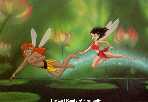 The
Earth Spirits
The
Earth Spirits
Earth
is the Mother Goddess. Gaea, Rhea, and Demeter according to the Greeks.
She is fertile and nurturing- bringing forth life from the soil. Earth
represents the densest of all the elements. It is the element of winter
and the night.
ELVES
In
Norse myth, the elves were great magical beings. They were divided into
two camps, the Ljosalfar, or light elves, who dwelt in the skies and in
Alfheim; and the Dopkalfar, or dark elves, who lived in dark and evil woods,
or deep underground, or sometimes under the waves of the sea.
GNOMES
Earth
is the elemental realm inhabited by gnomes. If you're lucky enough to spot
one in your garden, he will be serious and likely to be offering practical
insights. Gnomes dwell exclusively underground.
TROLLS
The
trolls feared sunlight, and were turned to stone when caught by the light
of day.
| Gods | Goddesses | Color | Type of Energy | Metals | Season | Direction | Time |
| Pan,Tammuz
Cernunnos |
Gaia,Demeter,
Rhea |
Green | Receptive | Iron, Tin | Winter | North | Night |
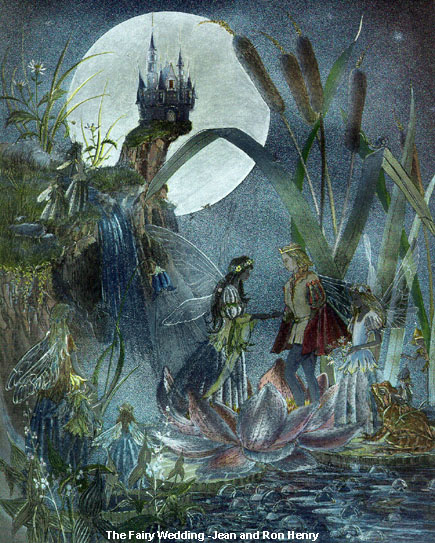 The
Air Spirits
The
Air Spirits
Air
is the power of intelligence. Without it we would perish for one could
go days without food and water, but without air we wouldn't last that long.
Air is also the power of the mind. It's season is the Spring and its time
is Dawn. The air is inhabited by sylphs.
Sylphs sometimes appear as butterflies, telling you to value what you have
today and not insist on guarantees and
"forevers".
Dragonflies, Luna moths and ladybugs are also forms taken by Sylphs attempting
to attract human attention.
| Gods | Goddesses |
|
|
|
|
|
|
| Enlil,Mercury
(Hermes)
Shu, Thoth, Vayu, Zeus |
Aditi, Nuit | Yellow | Projective | Tin,
Aluminum |
Spring | East | Dawn |
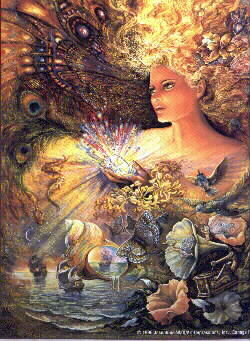 The
Fire Spirits
The
Fire Spirits
Fire
is the element of both creation as well as destruction. Just as a fire
may burn down trees, new life can grow in its place. It is an element of
the summer and a time of high noon. Both very hot times. This is the realm
of the legendary salamander
or
fire lizard. The salamander reminds us that all things are possible given
imagination and courage to walk through the fire.
|
|
|
|
|
|
|
|
|
| Horus,Vulcan
(Hephaestus) Agni, Lugh |
|
|
|
Copper,Steel |
|
|
|
 The
Water Spirits
The
Water Spirits
Water
is the element of the healing, psychic, and loving. Water is love. it is
purifying and cleansing. It is of Autumn and of the Dusk. Water plays a
crucial role in discovering other places of Faerie. Underneath the lakes
and the oceans sailors reported vast underwater cities and Kingdoms. Water
is ruled by the undines, mythical water creatures.
| Gods | Goddesses |
|
Type of Energy |
|
|
|
|
| Poseidon,
Oceanus
Llyr, Manannan |
Aphrodite,Mari,Tethys,
Nammu, Tiamat |
Blue | Receptive |
|
|
|
|
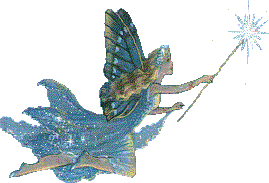


Most Nature spirits, fairy folk and kindred souls can be safely befriended. One must use common sense, though. If you get a distinct feeling of uneasiness, it is best to leave their territories at once and not court trouble. Most of them can be called upon in rituals and asked, not commanded, to help.
The ritual offering of wine and cookies is a good way to gain their help and friendship. They also like certain herbs, especially ginger. The offering should be placed outside, preferably near green plants or trees. Do not expect the food and drink to be physically gone in the morning. Tradition says that fairies and such spirits take the essence from human food and leave the outer form behind. Here is a listing of notable fairyfolk, or "named faeries".
AINE - Fairy queen of Knockaine. Moon goddess and patroness of crops and cattle.
AOIFE - A fairy queen and the mother of Cu Chulainn's son.
BEAN SÍDHE/BANSHEE - "Woman Fairy"; a spirit attached to certain families. When a member's death approaches, the family will hear the banshee crying. Not always terrifying.
BROWNIES - Wales, the Scottish Highlands and the West Country of England. They are about three feet high and dress in brown clothes. They have brown faces and shaggy hair. Brownies make themselves responsible for the house where they live by coming out at night to complete unfinished work. Any offer of reward will drive them away, but they expect a bowl of milk or cream and cake to be left out. Tradition says that brownies do not like teetotallers and ministers. If offended, brownies will create maliscious mischief.
CAOINEAG/KONYACK - "Weeper"; A type of banshee.
COBLYNAU/KOBLERNIGH - Mine spirits, similar to Knockers. About 18 inches high, dress like miners. Although they are ugly, they are good humored and will knock where rich ores are to be found.
CYHYRAETH/KERHERRIGHTH - A form of banshee. It usually cries or groans before multiple deaths by epidemic or accident.

DAOINE SIDHE (theena shee) - A name for the fairies in Ireland. Literally means "faery people."
DRYADS - All Western European countries. They ae spirits that dwell in the trees, preferably Oaks.The Druids turned to them for inspiration. Oak galls were known as Serpent Eggs by the Druids and used in many of their charms.
ELLYLLON (ethlerthlon) - Wales. Mab is the queen of those faeries. Toadstools are their food and the fairy butter which is a fungus found on the roots of old trees.
ELVES - Another name by which the Trooping Fairies in Britain are known. In Scotland they are divided into the Seelie and Unseelie Courts.
FERRISHYN (ferrishin) - Manx. Name for the fairy tribe.
FIN BHEARA (fin-vara) - (Also spelt Finavar or Finbar) ~ Ireland. The Fairy King of Ulster, sometimes called king of the dead. Although he was married to a fairy lady, he still courted beautiful mortal women.
THE GENTRY, or THE GOOD PEOPLE - Another Irish name for the fairies.
GNOMES - Earth Elementals. They lived underground and guard the treasures of the Earth. Gnomes are wonderful metal workers, especially of swords and breastplates.
GOBLINS/HOBGOBLINS - Originally a general name for small, grotesque but friendly brownie-type creatures.
GWRAGEDD ANNWN (gwrageth anoon) - Wales. Lake fairies.
GRUAGACH (Isle of Man) ~ These are dirty little half-human, half-fairy creatures. They appear as an elderly man who wears no clothes but is covered with dirt, twigs, etc. He enjoys roaming about the kitchen and causing disturbances.
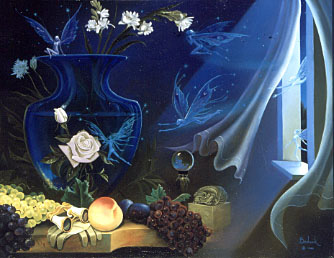
KNOCKERS/BUCCAS - Mine spirits who are friendly to miners. They knock where rich ore can be found.
LEPRECHAUN (lep-re-chawn) - A solitary fairy who makes shoes and generally guards a pot of gold.
MAB/MABH/MEDBH/MAEVE - Celtic fairy queen. Her tale is told in the Tain Bo Cuailinge, (Cattle Raid of Cooley) and her name was adapted by Shakespeare for use in "A Midsummer Night's Dream", from which work the name has moved into universal usage in English-speaking countries for the Faerie Queene.
MER-PEOPLE or MERFOLK - Mermaids; they dwell in the water, but they are human from the waist up and have a tail like a fish. They are irresistible singers who sometimes lure fishermen to their deaths. The Irish equivalent of the mermaid is the MURDHUACHA (muroo-cha) or MERROW. Also related to Merfolk are the SELKIE or SELCHIE, creatures who exist on land as humans but whose natural state is to live in the sea as seals.
OONAGH (oonah) - Ireland. Wife of Fin Bheara, the King of the Daone Sidhe. She is the ruler of the metals and stones of the Earth, and punishes suitors who are unkind to their ladylove. She is also a Mistress of Illusion and is the one who leads people astray into Faeryland.
PEOPLE OF PEACE - Another name for the Daoine Sidhe.
PEOPLE OF THE HILLS - Fairies who live under green mounds; subterranean fairies.
PHOUCA - This is the most fearful fairy in all of Ireland. It comes out at dark, causing injury and mischief. It can take on many different forms but usually appears as a dark horse with infernal yellow eyes and a trailing mane. It scatters livestock, knocks down fences and tramples crops. Sometimes it demands a portion of the crop and farmers have to leave an offering behind. You'll know when one is around because the cows won't milk, the chickens won't lay and all of your animals will think they're in a Stephen King novelPIXIES - The name for fairies in Somerset, Devon and Cornwall.
PWCA (pooka) - Wales. A version of Puck, but not like the Irish Phouka. They are helpful if milk is left out, but can also be mischievous.

SEELIE (BLESSED) COURT - These trooping fairies are benevolent towards humans, but will readily avenge any injury or insult.
SHEFRO - Male fairies who wear green coats and red caps. They hide in teh woods and lead travelers astray.
SÍDHE (shee) - Ireland, Scottish Highlands. Name for fairies and their subterranean dwellings. A barrow or hillock which has a door to a beautiful underground realm of the Tuatha or fairies. Most well known are the Tuatha de Daanan.
SLUAGH/SLOOA/THE HOST - The Host of the Unforgiven Dead, or pagan ancestors. The most formidable of the Highland fairies.
SUBTERRANEAN FAERIES - Fairies who live in brochs or hills. They travel from place to place at Imbolc, Beltane, Lughnassadh, and Samhain in order to change their residences.
TYLWYTH TEG (terlooeth teig) - Wales. The most usual name for fairies. If one wants to court their friendship, they are called Bendith Y Mamau (the Mother's Blessing).
UNSEELIE COURT - Fairies who are never favorable to humans. They are either solitary evilairies or bands of fairies called the Sluagh who use elf-shot against human and cattle.
WEE FOLK - A name for fairies in Scotland and Ireland.
WILD HUNT - The night hunt by the Sluagh with their terrible hounds. They are said to kidnap humans they encounter during their rides.
(Information above was collected on the Internet from various sources.)
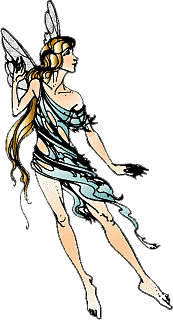
FAERY TALES
For me the Irish Faeries are the most interesting ones and those I like the best. This is possibly due to the fact that I hold a great love for Ireland and its people. There are a lot of wonderful stories and myths from Irish Mythology that include faeryfolk. Here are titles of some which you can enjoy.
Deirdre
of the Sorrows
The
Children of Lir
Brian
Boru
Niamh
and Oísin
 Ever
since the Tuatha Dé Danann agreed to abandon the sun-ruled land
to humans, faeries have made their homes in underground places, emerging
only after the moon has ushered mortals to bed. Anthropologists claim that
the good people take their name, Aes Sídhe (Folk of the Hillock
or Mound) from the large earthen mounds, or sídh, in which they
dwell; but faeries actually have diverse tastes in domiciles and
dark, earthen mounds are not in particular favor. Some dwell in the clefts
of hills, some in deep mountain caves or in shallow ones near and beneath
the sea; some prefer wild strewn rocks and others secluded glens. From
humans, faeries have inherited old castles, deserted graveyards, ruined
churches and the tombs of anchient warriors. But as human have become more
numerous, faeries have retreated from mortal habitations and sought the
seclusion of distant Atlantic islands and unsurpassable mountain ranges.
Many emigrated to America to explore new frontiers, but when these diminished
the faeries moved on.
Ever
since the Tuatha Dé Danann agreed to abandon the sun-ruled land
to humans, faeries have made their homes in underground places, emerging
only after the moon has ushered mortals to bed. Anthropologists claim that
the good people take their name, Aes Sídhe (Folk of the Hillock
or Mound) from the large earthen mounds, or sídh, in which they
dwell; but faeries actually have diverse tastes in domiciles and
dark, earthen mounds are not in particular favor. Some dwell in the clefts
of hills, some in deep mountain caves or in shallow ones near and beneath
the sea; some prefer wild strewn rocks and others secluded glens. From
humans, faeries have inherited old castles, deserted graveyards, ruined
churches and the tombs of anchient warriors. But as human have become more
numerous, faeries have retreated from mortal habitations and sought the
seclusion of distant Atlantic islands and unsurpassable mountain ranges.
Many emigrated to America to explore new frontiers, but when these diminished
the faeries moved on.
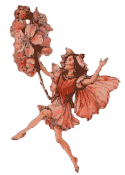 Most
land faeries dwell within raths (also called lisses, forths and forts)
which are circular areas of half an acre or so enclosed by stone fortifications.
In the ancient days when they lived above ground as warrior-gods, the good
people constructed them as defences against foes and as retreats in which
to play their music and create their poems. From any fort one can see the
next a mile or so to the to his left and another in the same distance to
his right. Underground passages link them all, so that if a man was brave
enough he could walk the lenghth of Ireland without seeing the light of
day. It is said that if a man were to sleep within the rath itself, his
mortal spirit would be taken away and that of an old Tuatha Dé Danann
warrior put in its place; thus would he know all the world's past. But
his glory, though intense, would be rather short-lived. For once he has
left the rath itself, his new-found knowledge would vanish and his wits
dry up and scatter like leaves. Despite all obvious disadvantages, it is
safer to enter a rath escorted by the Sídhe than to stumble in on
one's own. An abducted guest will be regally entertained and has the hope
of returning with all his faculties intact.
Most
land faeries dwell within raths (also called lisses, forths and forts)
which are circular areas of half an acre or so enclosed by stone fortifications.
In the ancient days when they lived above ground as warrior-gods, the good
people constructed them as defences against foes and as retreats in which
to play their music and create their poems. From any fort one can see the
next a mile or so to the to his left and another in the same distance to
his right. Underground passages link them all, so that if a man was brave
enough he could walk the lenghth of Ireland without seeing the light of
day. It is said that if a man were to sleep within the rath itself, his
mortal spirit would be taken away and that of an old Tuatha Dé Danann
warrior put in its place; thus would he know all the world's past. But
his glory, though intense, would be rather short-lived. For once he has
left the rath itself, his new-found knowledge would vanish and his wits
dry up and scatter like leaves. Despite all obvious disadvantages, it is
safer to enter a rath escorted by the Sídhe than to stumble in on
one's own. An abducted guest will be regally entertained and has the hope
of returning with all his faculties intact.
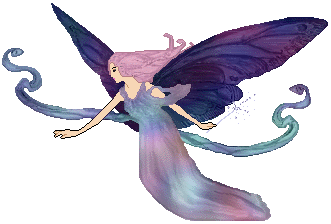 The
cave faeries have less intercourse with mortals than their hill-bound,
mortal-abducting brethren. In fact they are indifferent to mortal doings,
being far more interested in maintaining their reputation for fine horsemanship,
which they have held since the renowned times of the Tuatha Dé Danann.
Caves are known to make excellent stables. Left in peace (they loathe being
disturbed by us newcomers) they are harmless, but their vengeance is devastating
and their tolerance questionable. Oftentimes, coming home late at night,
fishermen see them traversing the underwater, coral roads they have built
to link their cave homes. A wise fisherman will bow them the right of way
and make a note henceforth to avoid the area. When faeries of all
locations travel abroad, they most often make camp under a hawthorn
tree. Under its branches they feel at home. On May Eve when the blossoms
are open they leave their underground homes to dance wildly about the tree,
daring mortals to join them. But May time (or indeed, any time) humans
had best respect the Sídhe's sacred tree, for he who plucks a branch
will fall helpless to the faerie power.
The
cave faeries have less intercourse with mortals than their hill-bound,
mortal-abducting brethren. In fact they are indifferent to mortal doings,
being far more interested in maintaining their reputation for fine horsemanship,
which they have held since the renowned times of the Tuatha Dé Danann.
Caves are known to make excellent stables. Left in peace (they loathe being
disturbed by us newcomers) they are harmless, but their vengeance is devastating
and their tolerance questionable. Oftentimes, coming home late at night,
fishermen see them traversing the underwater, coral roads they have built
to link their cave homes. A wise fisherman will bow them the right of way
and make a note henceforth to avoid the area. When faeries of all
locations travel abroad, they most often make camp under a hawthorn
tree. Under its branches they feel at home. On May Eve when the blossoms
are open they leave their underground homes to dance wildly about the tree,
daring mortals to join them. But May time (or indeed, any time) humans
had best respect the Sídhe's sacred tree, for he who plucks a branch
will fall helpless to the faerie power.
Source: Carolyn White "A History of Irish Fairies"
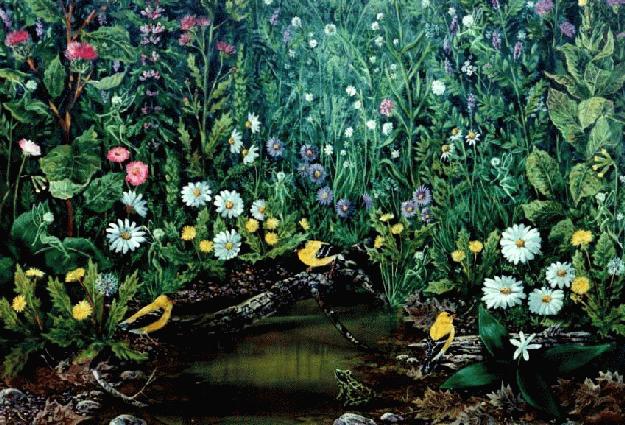
CONNECTING WITH FAERIES THROUGH HERBS AND FLOWERS
My partner and I have a fairy garden that is deliberately arranged to be attractive to the People of Peace. Not only is what is planted there deliberately selected to be attractive to the Sidhe, but the layout and arroangement of what is in the garden is created to make a retreat for the Folk. Some of the plants below are attactive to faeries, as are the accoutrememnts discused following the list of herbs and plants.
Basil- The Fae of the Basil help us awaken greater discipline and devotion
Buttercup- This flower and its Faerie bring healing energies, They help us rediscover our selfworth
Carnation- Their energy is healing to the body, contact with them strengthens the aura
Clover- The clover Faeries assist in finding love and fidelity
Daisy- The daisy is a favorite of Dryads(wood nymphs) The Faeries help awaken creativity
Feverfew~ Helps repel unfriendly fairies and attracts money to the homeowner.
Gardenia- This special Faerie stimulates feelings of peace, The Fae of this flower are VERY protective towards childeren
Heather-The Fae of this flower are drawn to humans who are shy
Jasmine- These Fae love to envoke plesent dreams, They have also been known to help develope mental clarity
Lily- These Faeries help in the development of purity and humility
Lemon Verbena- Helps sleepers see Faeryland in their dreams
Rose- The Faerie of the rose can help in all aspects of love and fertility
Sage- They awaken a sense of wisdom in your life
Snapdragon- These bring humans great protection
Thyme- Thyme draws the wee Folk into your sleeping chambers
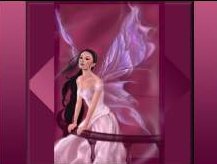
ATTRACTING THE FAY
Set out birdhouses, birdbaths (float flower blossoms), bird feeders and bat houses.
Grow plants and flowers that are attractive to bees and butterflies. The fae are attracted to where they are.
Create a small fountain, waterfall or fishpond (fishponds attract all sorts of wildlife)to attract faeries and water sprites. Anything that reflects light or is colorful and moving will attract the gnomes and elves.
Leave an area of your garden a bit wild and uncultivated. Dedicating it to the faeries will make them feel very welcome.
Don't remove mushrooms or fungus from your garden as the faeries regard these as delicacies.
Faeryies are very attracted to gardens where they feel they are welcome and gardening is done in sympathy with nature and the plants that are their love and charges.
Always leave at least a small wild area that is not cultivated (though it can be cut carefully several times a year - like a wild meadow) or disturbed
Grow plants and design the garden to attract wildlife
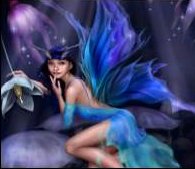
Choose natural wild flowers, herbs and non-sterile hybrids. The faerie are not sure of the energy of the modern hybrid flowers,
It was an old tradition to build a small faery house out of natural materials and to grow within it mushrooms and wild plants that they like.
Sit in the garden and listen for their singing. Hang up wind chimes and listen to the wind through the trees and recognise the faery voices within it.
Clean water is very attractive to all faeries, not just the water faeries. A bowl of crystal clear water placed in a room sweetens the atmosphere and forms a link to the spiritual planes.
Faeries love beautiful, pure objects and may even be said to have rather flashy (but not really gaudy) tastes in jewellery. They love gold and silver and precious gems and can be very attracted to good-quality crystals (that have not been extracted by unkind means).
Faeries themselves will be seen dressed in green finery, such as foliage and pretty flowers round their waists, heads or necks.
Brownies have always traditionally liked small offerings of milk, honey, cakes or ale to be left out for them and in turn will help around the house.
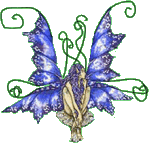
To attract faery energy to the home have some pictures or figures of them around, particularly if there is an area of the home set-up as a quiet place, where you can meditate and ask for their help. A few acorns gathered in a lane, a flower found lying on a verge (don't pick them from living plants), a few autumn leaves will always be recognised and appreciated. Each morning thank them for their help and ask that that help continues.
Faeries are attracted to anything that glitters. Get a small basket and place in it offerings to the faeries such as candles, ground ginger, clover (only the three leaf), thyme, barley, foxglove, primrose, roses, and moss. Tie the basket with bright colored ribbons for an added affect. Be sure to replace the items often, as the faeries use that which is inside and leave the outer shell of the objects.
Oak Hawthorne, and Ash Trees are among the best natural places to find faeries. Outside of your faery garden look in these natural settings.
Provide for faeries places in which to build their residence, shelter from the weather, and happiness.
Every time something good happens in your garden, or you have good fortune in your life, go outside into the garden and thank the Fay aloud. Most tales of faery curses arise from situations where the recipients of faery gifts or benefits were greedy or ungrateful.
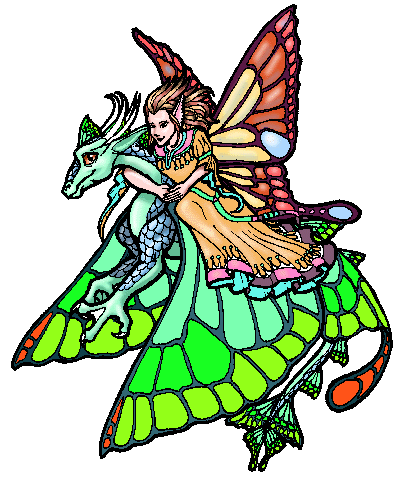
Thank you for visiting me in the Halls
of Faery.
Please let the Dragonfaery guide
you where next you wish to go
